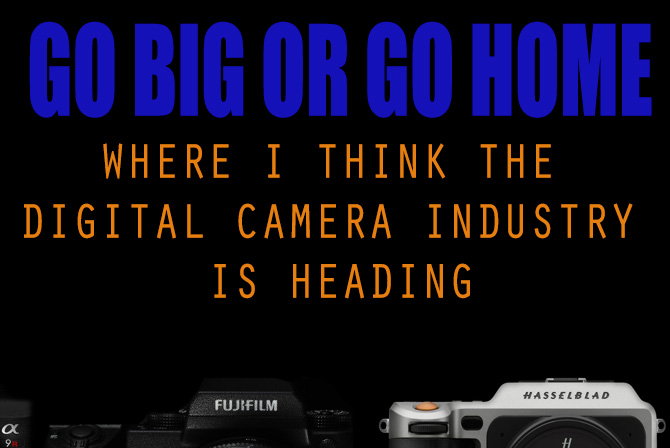
Where I think the Camera Industry is Headed.
By Steve Huff
Photokina has come and gone and by all reports around the world (wide web) it has shrunk again with some saying it matched 2012 and others saying it was way down. Over the years it has been shrinking in participation and attendance, and what is to blame? I don’t know but I have a guess. Smart Phones, and even the availability of USED cameras, you know.. last years models that are still amazing and can be had for half the cost.
Digital Imaging has grown by leaps and bounds since I started this website/blog. I have been here at this website not since the beginning (I have been participating within the online community ever since the 1st digital Canon DSLR the D30) of digital but since the 1st days of Mirrorless with the original Olympus PEN and the Panasonic G1 and Leica M8! During those times, the smaller more compact mirrorless segment of the camera industry was struggling to get out of the gate. Many DSLR fans bashed and bashed and bashed the poor little Micro 4/3 system and it’s smaller sensor. Many saying Micro 4/3 would be dead out of the gate. Well, that did not happen. Instead, what did happen was that those first Micro 4/3 mirrorless cameras paved the way for more and much better mirrorless cameras to be developed over the following years.
It was clear, the camera buying public wanted a smaller camera system over a DSLR that still gave wonderful quality results. Some were tired of the big DSLR’s, as many who were buying them ended up leaving them behind when they left the house. Only to be reserved for family shots, events, vacations, etc. With mirrorless, we now had smaller systems that we could take with us everywhere if we wanted. They were also fun to shoot, and fun to look at sometimes (The Pen series for example). Now this was BEFORE smart phones came to be with their wonderful and capable cameras.
So along comes Sony with the NEX-3 and 5 and not long after that a stream of upgrades from Sony..then more from Olympus and Panasonic, then Fuji’s excellent X100 series and so on. Soon, we have almost every camera maker producing a smaller mirrorless solution. The early days of mirrorless were OK. Slow AF, inaccurate AF, so so high ISO performance…and then BAM! All of the sudden we were getting amazing speed, quality, smaller size and results that matched the DSLR counterparts. We were still missing a “PRO” level Micro 4/3 body of course..until the fantastic (still fantastic today) Olympus E-M1. That camera did so well for Olympus due to the rugged build, great speed, soft quiet shutter, being shock, freeze and splash proof and of course the highly capable IQ coming out of it in almost all situations except the higher end of the ISO range, which was always M 4/3’s weak spot.
So we were now getting flooded. Sony NEX-7 and the new Alpha series, Many PEN models from Olympus, the Fuji X-Pro, XT and XE line, Samsung went at it hard with small bodies and even a large NX1, which turned out to be their last hurrah (so it seems, they were absent from Photokina this year). By 2014-2015 there was a FLOOD of mirrorless cameras out there for us to choose from. I mean, there are A TON of cameras out there in circulation. Many on the used market. Most are fantastic and can be used for years to come while giving us top quality.
We have gotten to the point where current camera tech has reached a peak. What comes out today has to be UBER exciting for us to get our emotions and heart to co-operate and want to BUY a new camera. When I see a Leica M or Leica SL, my heart goes boom boom boom. Those are special, unique and desired by many. The cost is what kills the dream of many to own one. When I see a Sony A7RII I think “Wow, this is just a great camera. I could use this for 10 years and be happy as it has all I need”. So for me to upgrade these days, a camera has to be simply a WOW product. I think many of us are in the same boat.
Many of you here own a recent model Sony A7 series, or a Fuji series or an Olympus or even a Leica. Many of you are 100% happy with your current camera. SO this means every year, there are less and less NEW cameras sold. We already have amazing tech and quality, and even if we have some really old camera and want and upgrade, many go to the used market and save crazy money on a used camera that performs as new. So again, less and less new cameras are being sold. This leaves some manufacturers wondering what they need to do to keep the train moving at a fast pace.
So where do I see the industry going? Well, I think we will be seeing slower product refresh times. Instead of the 6-12 month refresh of some, that may turn to 2-3 years. Leica has a 3 year (or more) life cycle on most of their German made cameras (The M, T, SL, S). Olympus had a three year break from the E-M1 to the Mark II and I think even Sony MAY BE slowing down with the A7 series. So first, camera releases, I think, will start to be spaced out more and more. The days of the 6 month refresh may be over 😉 But this is actually welcome to most.
I also think many models will die out. Smart phone cameras are getting better and better and every year they take a bite out of REAL camera sales. A phone is always with you, and always ready to get the shot, and the IQ for 97% of us is good enough. It truly is a small niche of us who are obsessive over image quality. For the masses, most are just fine with their smart phone camera, which is going to make it tougher and tougher for these camera companies to thrive as they have over the past 10 years or so.
So with the smart phone taking over, I think we are already seeing what will happen within this industry.
I think the new trend, as shown by Hasselblad and Fuji this year will be GIANT sensors. We are forging past full frame 35mm and heading into medium format styles of sensors. The bigger the sensor the more rich, the more beautiful and the more WOW we get in our final image results. More dynamic range, better color, etc. It’s a fact, today we get bored easily. Our attention spans today are the shortest they have ever been. I blame the internet for this, and many of the world’s problems, but for cameras…this means that while FULL FRAME digital was hot and awesome years ago when it was new, but too expensive. Today we can get full frame bodies on the cheap (used Sony A7 for example) so today, Full Frame is old news. Many are bored with it and wanting more.
So with Fuji entering the MF world with the GFX 50s, and Hasselblad has the X1D (which looks BEAUTIFUL to me) I feel Sony is not far behind. I see Sony as really being the #1 company to push digital imaging tech and limits. I do not see them missing the large sensor push which I feel is the next big phase of digital. We have these medium format bodies now from Pentax, Fuji, Hasselblad, all under the $10k mark. Sony already makes fabulous MF sensors, so it would be a no brainer for them to get into the MF game and release something like a Sony A10 with a Squared off body, a little larger than an A7 and include their medium format sensor in the body. Then have an A9 Pro to be the pro A7 many want to see as well. Would make sense.
So I see these companies and digital imaging to continue the trend. We started with point and shoot sensors, then APS, then Micro 4/3, then full frame and all that is next is Medium Format, and it has already begun. I think we will see less and less of the point and shoots (another continuing trend) and less of the multiple models (like the three A7 models released at one time) and we will start to see more and more really exceptional cameras aimed at the enthusiast niche.
Special cameras. I think Leica will remain unaffected because what they offer is so unique and special, and they already have a tiny tiny market share, and those are from people who LOVE Leica and will not really want anything other than Leica. For the others like Fuji, Sony, Olympus, Pentax, etc I think we will see more time go by from release to release and when there are cameras announced I think they will be more special, more high end. No camera company can beat the Smart Phone at its own game, so the Point and Shoot’s slow death will keep on progressing IMO.
With so many used deals out there on recent releases, more people getting tired of the constant upgrade game, technology sort of peaking right now for digital imaging, and smart phones being plenty good enough for the masses…it’s going to be a tricky route for most of these camera giants to navigate. I feel with concentration on making cameras the best they can be in build, speed and performance as well as adding and going larger with the sensors (as has already begun) in a mirrorless body will be what we see over the next few years. I think we will still have Micro 4/3, APS-C, and Full Frame of course but these new bodies will have to have something special about them for most enthusiasts to bite. I also see VIDEO as getting bigger and bigger and bigger.
I would be excited by a new Leica M, a new Sony A9 Pro, a new Sony Medium Format body. I already am excited to test the new Olympus E-M1 MKII and see the new Hasselblad and Fuji MF cameras as well. So today as we near the end of 2016 I feel we have some amazing cameras to choose from as far as new releases and current releases. We also have a hell of a lot of used options, so being a Camera Enthusiast, Photographer or even a Pro today is great. We have many options but 5 years from now, we will probably have a smart phone that gives us everything we get in todays mid to top mirrorless or DSLR’s. THEN we will start to see what truly happens to the industry. Change is gonna come, that I know.
Steve

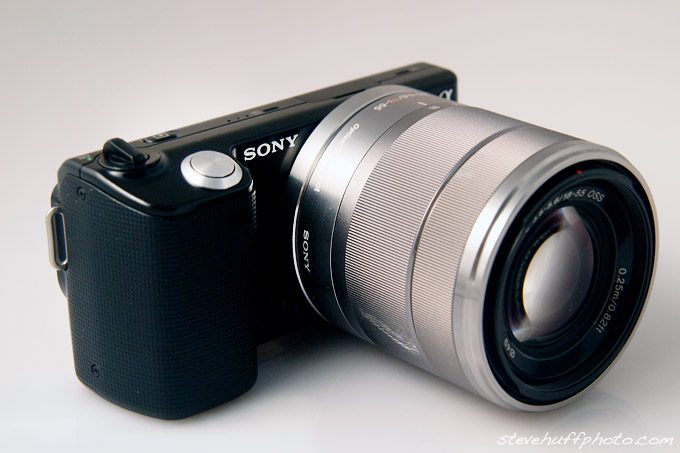
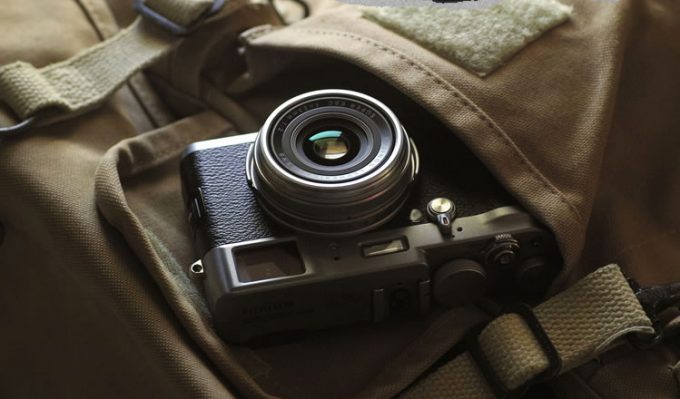
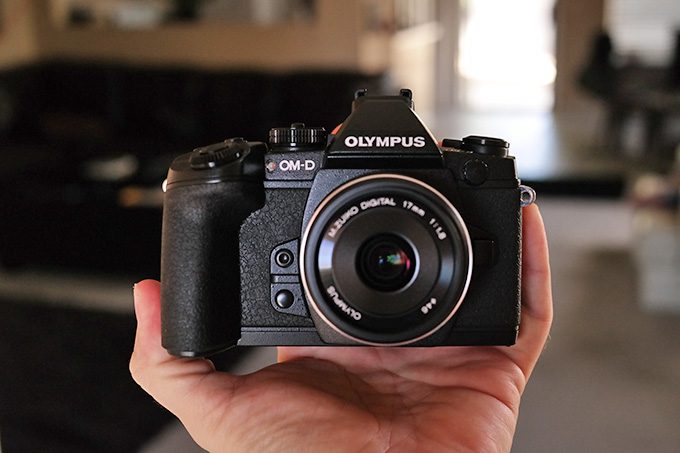
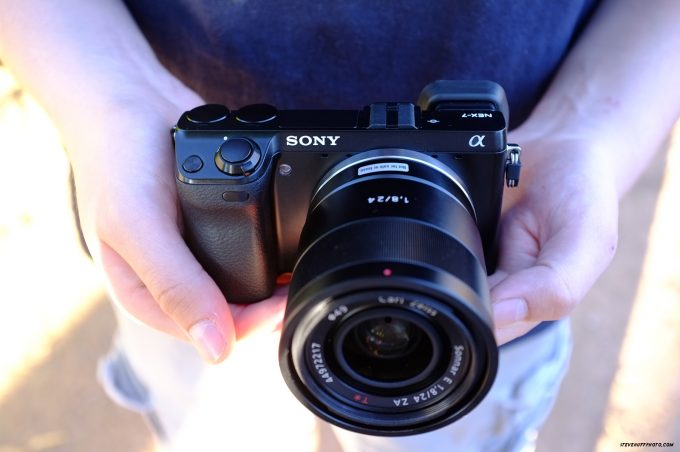
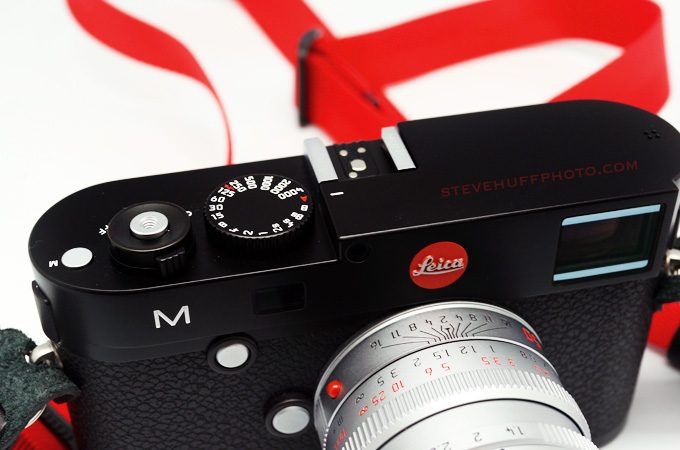
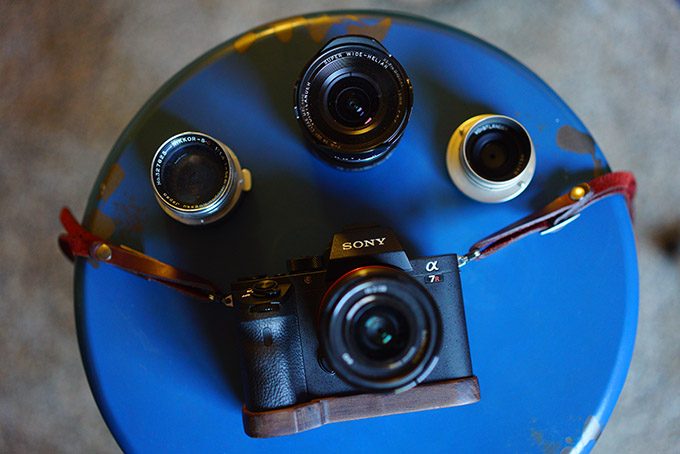
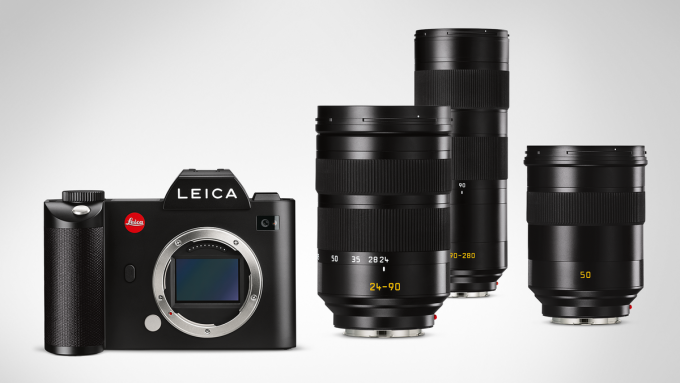
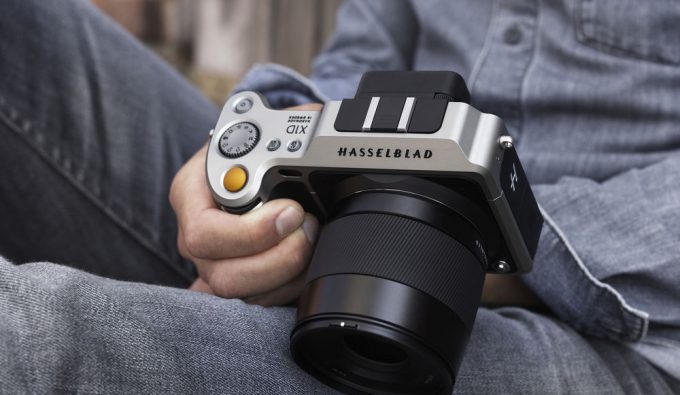
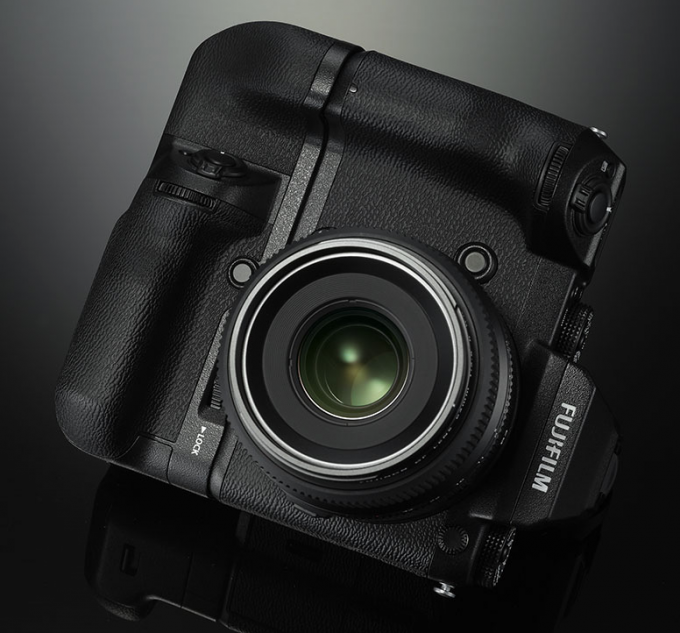
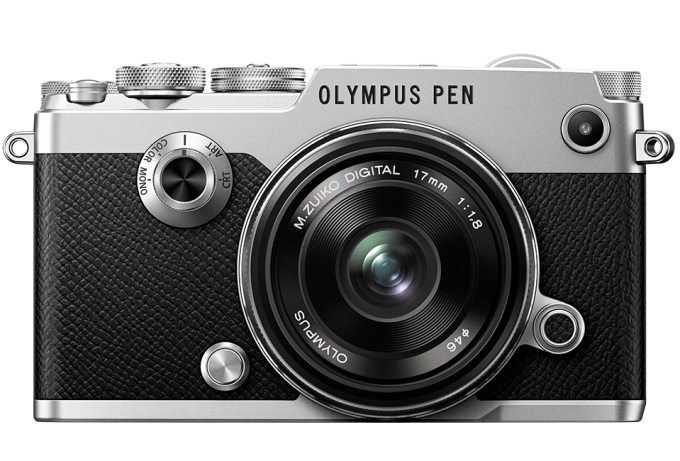

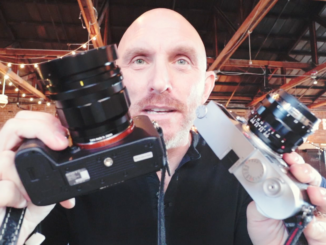
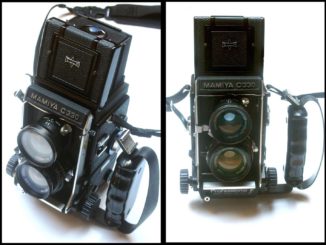
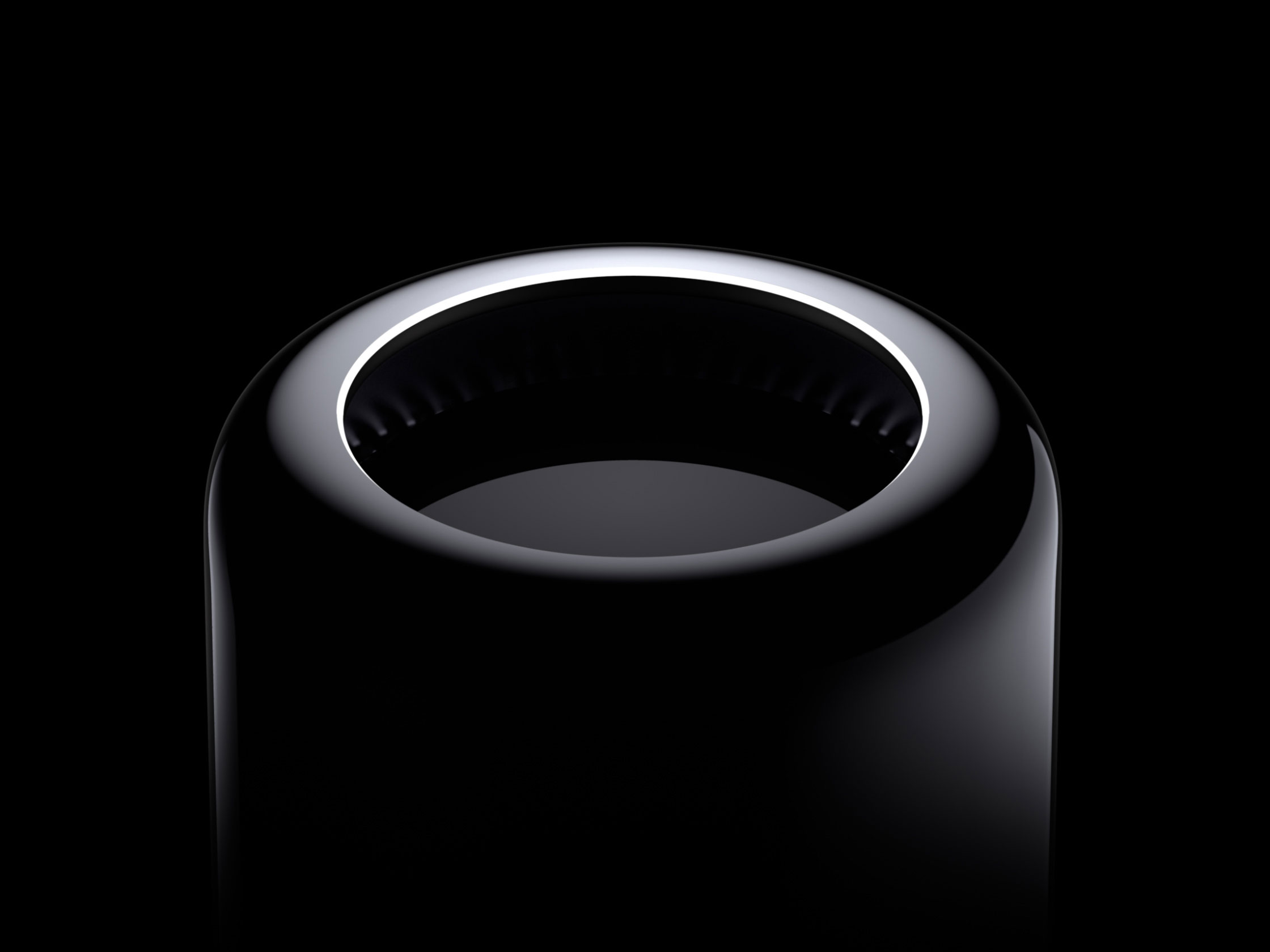
Doing some fast math yesterday M43 has about 3 1/3 fstop advantage over typical smart phones. That is HUGE plus the interfaces are typically much better.
BTW my full rough estimates
Full frame – 5 1/3
APS-C – 4
M43 – 3 1/3
1/2.5 – baseline
Better user interface? I don’t know about you, but usability of my Fujis and Olys beat an iPhone or Galaxy phone any day of the week. The advantage is that it is always with you and that its technological limitations make taking snapshots a breeze. How can an ilc ever compete on size and always availability? It just can’t. Fact. ILCs have to offer a lot more than a phone camera so people will lug them along. I think they already do. But most people do not appreciate that and probably never will.
🙂
Just quickly: I think Leica might release the new M on October 10th, due to the tenth anniversary of the digital M – 10/10/2016.
For actual photographers and not gear heads none of this will mean much.
It’s a narrow market that will actually see either an artistic or monetary benefit from having super high res images.
The manufactures know this all too well that. It doesn’t matter, because it’s a very large market who will want, lust over and buy these cameras, and all the new lenses, even though they don’t need them. I guess we can look forward to super high res mediocrity and massive pictures of peoples cats!
Steve,
I would like to disagree that the camera companies cannot keep up or catch up to the SmartPhone. I think we need to challenge them to build better user interfaces, better connectivity, better thinking about how people actually use cameras. Not “photographers” but people. Tony Northrup just did a similar video post to yours.
My primary camera is an iPhone 7 Plus or maybe one of my M43 cameras; it depends upon the need. For example I have logically “glued” my GX-8 to my 100-400 as my reach out to nature system. Each camera has a primary use case. Yes there is overlap but you get the idea.
I do not need a medium format camera today but I can rent one if I do… I do not want or need a Leica but they have a cache that is interesting and from looking at some of Steves images I would say they produce great images.
Billions of images are taken by millions of people most of them are either lost in the digital ether or posted on Facebook and the like. That is today’s Kodak moment in action. I do not see that changing soon. So if the dominant image sharing system is in a web browser on a 5in screen I think just about ANY camera can fulfill the need.
We need cameras that solve the problem of capturing images on the fly and delivering them to the Internet, etc. simply and effectively. Solve that and produce the IQ we photographers want and you will have a winner Mr. Camera Maker..
This is a great time to be taking images.
RJF
PS the iPhone 7 Plus portrait mode beta is quite interesting and a lot of fun. So folks do not knock it!
I’m thinking Leica should come out with a medium format version of the SL. Functionally, there’s not a lot of difference between the SL and the S (007). Going mirrorless would shave a fair amount of weight from a hefty camera and give competition to Hasselblad’s X1D. If they have room in their lens coverage, increasing the size of the sensor (even if not increasing the pixel count) will improve image quality even further. They may keep the styling of the S to encourage adoption, and even call it the S Typ 008. If someone really needs an optical viewfinder, they can continue to make the 007.
They could also use the old S lenses with an adapter to give the correct focusing distance until they redesign them for the mirrorless. An adapter on the 007 would also give the ability to use the new mirrorless lenses. Adding in image stabilization would be a big step forward for a medium format camera as well. They may even be able to make the lenses shorter in length, making the system even more compact and lighter.
I realize that the 007 is still relatively new, so I don’t really expect to see this soon, but producing a medium format camera with the size and weight of other brand DSLR’s would be a significant selling feature.
Computational Photography- L16, etc. This is the future.
I’m happy for you. Fondling those cameras was obviously a very moving experience for you. By the way, it may surprise you to learn that people also discuss cameras on the internet and can listen to top photographers talk about their work, too. The internet is funny that way. These days you don’t actually have to go anywhere to find out what you need to know. But camera fondling is a whole other level and you’re right, it’s hard to do that on the internet.
I’m happy for you. I’m sure caressing those cameras was very moving experience for you. By the way, it might surprise you to learn that people discuss cameras on the internet too. You don’t actually have to be where they are to exchange ideas.
Yeah something like that, but I’m hoping for something truly compact—a folder so it can be pocketable. Not a real 6×9 but something with the sensor of their current MF system and a 35mm equivalent or so folding lens. Good video ability would be a plus (and not too hard .
I really think if they released something like that, I’d be happy for 90% of my shooting needs for the rest of my life.
No They really haven’t. In shot tests, you can tell trickery is afoot. It will also always be a soulless software version of the bokeh rendered by real lenses.
In short, it sucks:
http://www.imore.com/portrait-mode-tests-iphone-7-plus-vs-honor-8
Official photokina 2016 visitor figures are now out: 191,000 or 6,000 more than last year.
Thanks for your kind words, Bob. Still, I’d like to point out a few things. I believe it’s good to look a bit broader and also to look at history. That’s why I often compare with music, a domain that I know pretty well. When you think about how in history artists of different disciplines (painting, music, literature…) often exchanged ideas, you’ll understand the sense of it.
In music the digital revolution began in the early 80’s. We saw digital mixing desks, digital synthesizers, etc… First very expensive, later becoming cheaper and thus “for everyone”. In the beginning of this cheaper generation, we saw a simplifying of the controller towards “screen control” (to save money, but also because one believed that more possibilities were offerde in this way). But after a while, one realised the vital importance of the controller in the performing process. So what happend? Well, not that digital disappeared. Of course not. But the controller came back, even much and sometimes totally in the style of the analog era. The analog style controller had proved to be offering the best performing ability. Not weared, because it had evolved during such a long time to meet the needs of the performer – even during centuries, in case of the musical instruments. So what was to conclude: 1) digital was here to stay. 2) the analog style controller proved to be superior and was integrated in the digital equipment. 3) the analog itself never disappeared and even had a serious revival. (A good example is the turntable.)
What I believe is that in photography, a similar process will take place. The evolution towards smartphone photography will not stop of course. But for everyone that works creatively, the controller will proof to be essential. I guess you can fill in the rest of the proces, in analogy of what happend in music.
So far for my old mind. 😉
It’s always interesting to consider what the future holds. Personally, I honestly believe the long term future of photography will be: medium format quality achieved with tiny pocketable devices (including communication devices of course) using CURVED SENSOR TECHNOLOGY. Google it! A curved organic sensor is tending towards replication of the design of the retina in the eye, and the resultant lens construction will be simpler yet better. This technology will make all past & present systems seem like worthless dinosaurs, with a demise not unlike what has happened to cathode ray television sets, for example.
Hi Steve, I am a bit late to the party here but humour me and allow me to throw in my two bobs worth, (20c in US speak).
I expect that the Net is largely responsible for falling attendances at trade shows like Photokina, afterall for overseas attendees unless you can write it off on tax or tie it in with a holiday, what exactly is the point. I can see everything, including videos within hours of release and of course we have levelled out in terms of releases and developments and as would be expected of any mature technology much of the initial excitement has dissipated.
But the more pressing issue is where to now, I am not sure I agree with the MF route, but I am happy to proven wrong. Bottom line is I feel, unless the prices go into free fall, which I doubt, the number of takers will remain small, especially considering the obvious trade offs re weight, bulk, need for tripods to liberate the benefits etc. My gut feeling is that a price target of somewhere south of $4000 is needed to reach a point of critical mass in terms of viable market appeal, above that sure they will sell a few cameras but I suspect the growth for serious shooters with regular financial means ( by far most of us) lies eleswhere.
First, it is entirely possible to obtain most of the benefits of MF via software ( either in-camera or post) but at this point we are only really at the starting gates with Olympus and Sony in particular chomping at the bit.
(Note: I don’t for 1 min doubt Sony will produce an MF camera as a halo product, though I doubt they will produce another lens line, so I imagine it would be compatible with other lenses already on offer from other makers.)
Detail, noise, colour fidelity can all be vastly improved via image stacking, make the process fast and seemless and the benfits could be enormous. Imagine what full global shutters, smart in-camera image alignment and super powerful processing could liberate. Combine that with super high grade fast lenses and even smaller formats could produce amazing results. Does this not sound something like the path Olympus is currently embarking on.
The main benefit I see with MF is a different DOF rendering, but in reality the additional 40-60% of image area on offer is not enough to ensure a significantly different look, especially considering that the lenses on offer are generally slower and faster options whilst possible would be inconveniently large and heavy. For MF to really make sense “DOF wise” sensors of 6 by 7 cm minimum or larger are needed and certainly then we would see something that might justify the expense and lack of convenience, but no one is going down that path and the expense would be astronomical.
My gut feeling is that the new frontier lies in two areas, super powerful in camera processing and lens development. In many ways this is already underway, the camera makers no longer have creative dominance over the lens arena, in fact the real juicy developments are not coming from the big two (Canikon) but rather a whole array of 3rd party makers who are producing amazing options for Sony E and FE mounts and M4/3.
There are still many ways lenses can be improved and tweaked, ultra fast short range zooms for M4/3, variable field curvature lenses ( not new, Minolta pulled this trick off decades ago), super corrected very fast m4/3 lenses (like the new 25mm f1.2 Oly). What about ultra fast fixed focal length lenses on 1 inch compact cameras.
The possibilities of image processing are extraordinary and even though smart phones lack ultimate image quality there are many apps that unlock unique options that can lift image quality well beyond the smart phone norm via clever processing and shooting methods, opening up the Raw option on iPhone will now rapidly escalate the efficiency and ability of many of these apps. My main point being that a camera with a larger sensor, say 1 in or M4/3 and enough processing power could truly leverage image quality way beyond what we currently see as the accepted norm using much the same methods.
There is is course much more that can be offered that will get photographers excited and buying, but this year sadly there has been little of it on offer, DSLRs are these days about as exciting as day old bread ( to me anyway) the interesting Nikon compacts seem to have become vapour ware and I feel the only cameras that got me excited came from Olympus and Sony.
Finally I reckon the EVF is starting to hit its stride and will become the new battlefield for supremacy, that is something many serious photographers will happily pay for, frankly I am surprised that neither Sony nor Olympus pushed this to the next level this year, (Leica have shown the technology already exists) but I expect Sony will with the next big model release and then market the pants off it, meanwhile where are those Canon and Nikon DSLRs with EVFs?
Oh and in closing, a little while back a did some blue sky thinking on what might constitute the ultimate new camera option and wrote a blog entry on it, it can be found here:
https://braddlesphotoblurb.blogspot.it/2016/07/formats-compared-blue-sky-thinking.html?m=1
I also wrote an article a couple of years back on “what if Apple actually released a new camera” I reposted to my new blog a couple of months back and it can be found here:
https://braddlesphotoblurb.blogspot.it/2016/08/if-apple-really-designed-camera.html?m=1
Cheers from Brad
Sorry for you, obviously you did not have the opportunity to join the Photokina. Being there for a couple of days was so much more than surfing on the websites of manufactures and bloggers. Comparing the the bulky SL with the 50 Lux with the gorgeous new Hassy, and taking some photos with them, is something you can`t get online. Talking to people sharing your thoughts, and listening to top photographers like Marco Grob and many others is an experience I´am not going to miss. So I`am not saying bye bye to the internet, dealing with it 12+ hours a day, but it will never ever be a substitute for the emotion of touching and using gear and talking to people, instead of typing comments about things I have heard about.
Technical issues aside, the one thing that’s missing from the conversation is the user experience. Perhaps I’m betraying my age, but shooting with a camera for me is an entirely different experience than shooting with a smartphone. I just see things differently, perhaps because I’ve been behavioralized by thinking photographically through a viewfinder, lens, flexible speed and aperture, etc. I’ve shot every format from MF, 35mm, FF and iPhone, from MF film to dozens of incredible Hipstamatic variants and created amazingly good images from all formats. But there’s just something missing for me with smartphone photography–even though you can do things in post that are virtually unachievable in Photoshop, Capture One or Lightroom. My relationships to my subjects, how I see things is just different and “less than,” with a smartphone. I think cameras and smartphones are almost different art forms. One is photography, the other is image capture.
I used to think the smaller format cameras (phones, point-and-shoots) can never touch the shallow DOF of larger format but looks like even that is changing with the multiple-camera technology. Such a clever idea, it can simulate DOF, give you 3-D if desired, very promising stuff. Combining output from multiple sensors can probably do wonder for low light as well? Sure it’s not the “real thing” and the enthusiast will always lament about lenses like Noctilux, just like how car enthusiasts lament about glory days of NA engines while masses moved onto forced induction. Of course I’d love to own a Noctilux if I can effort it, but if my phone can simulate the same effect with 1/10th of the price and fit in my pocket, why wouldn’t I take it.
On the other hand, with small sensors comme big lenses too, just look at the new 25mm 1.2. The smaller the sensor, the bigger the aperture you need to get outstanding IQ and reduced DOF.
Interesting thoughts on the way ahead, Steve! May I add a few of my own:
Back in the thirties and forties of the last century, the Rolleiflex was the ‘norm’, shooting 75mm f/3.5 lenses on 6×6 film. Then 35mm format took over, mainly for convenience reasons, and photographers learned that they could get similar ‘look and feel’ by using a 40mm f/2 lens. The term ‘bokeh’ entered the English language and was found to have more to do with image quality than just sharpness, grain (noise) and other technical factors.
In the early days of digital photography. sensors had to be small, to keep the cost down, and sensitivity was quite low, making the resulting images ‘noisy’. For several years, the emphasis was on improving the technology, to overcome these limitations, while other aspects of image quality were ‘on the back burner’.
i think we are now at the stage where ‘image quality’ can return to the fore. The laws of physics determine that different sizes of sensor will produce different results, regardless of the technology employed. There are places for different sizes, depending on our particular interests. For table-top photos of small-scale models, I find that small-sensor cameras are excellent, because they produce perspective effects and depth-of-field that are ‘in scale’ with the models. For portraiture, larger sensors are needed to get the balance of factors that make the subject stand out from his/her surroundings. There is no universal camera that can meet all the requirements of a dedicated photographer and I hope that the trends in the industry will reflect this.
On ‘video’, I have mixed feelings. The ‘art’ of still photography is very different from video and I personally find it difficult to combine the two. The increasing speed of digital processing, however, is making it possible to shoot at video frame speeds and extract the ‘best’ still frames afterwards. This may be relevant to some forms of ‘action’ photography.
Sorry to break your bubble, but Apple is trying to emulate that full frame look with the iPhone 7 plus this year, not in 10.
One more dismal note about cell phone cameras. Not only are they free–you cannot buy a cheaper phone without the camera–they are also mandatory. What? That’s right: “these days, everyone needs a cell phone. It’s a basic necessity these days. Superman himself cannot return because all the phone booths have disappeared. So, whether you like it or not you will buy a product that comes with a “free” camera. That’s not all: it comes with a free stereo system as well! One that, for most people, makes buying a separate “stereo system” (what is that anyway?), physical CDs, television systems, so no DVDs either. Don’t worry, the high end $ 30,000 and up stereo system will still be purchased by those who appreciate high quality and who have the money, but not the cheap consumer systems that you once had to have. Somehow, that too sounds just like the camera industry. And you carry it with you all the time. Hey, you don’t even need any headphones anymore; they’re also free and lost their cables as well. How many industries . . . oh, there went the wrist watches as well. But again, not the expensive high quality “jewelry” versions. Lenses, huh. Perhaps Leica should get into the cell phone lenses business with the Chinese while they still can. Oh, right. Maybe Sony should spin off its successful sensor business. Oh, right. This is serious: my grown kids have no interest in inheriting any of my extensive CD music collection. I assumed one would want the cameras, but now I’m not so sure. And yes, for them those would be free as well, but seemingly unnecessary too. To heavy to carry around. The camera/lens world we all love, cherish and use so much will always be around, but so will view cameras, black and white film, canvas and oil paints, and charcoal and paper. So, not to worry. Meanwhile, where’s Steve’s great review of the new Leica M camera model? I’m really missing that now. Patience.
Concerning your doubts about Olympus and Panasonic: Even if smartphones would equal m43 in IQ, most photographers would favor a small system camera with an excellent lens system over a smartphone. In addition, m43 is all most photographers ever need, since these cameras became fine tools, even capable to print larger than most of us ever need. Of corse, larger format cameras show superior tech specifications, but that has its price for a questionable relevance.
Yep, good image quality in as compact package as possible is what gets me excited as well.
After getting a Nikon J1 I have barely used my larger cameras for the last few years so I am selling them and will properly buy a micro 4/3. I would have gone all in on the Nikon 1 system, but it looks like a dead system and they never got around to making a macro lens.
Really?
It looks to me like Apple has decided to disregard some of those “laws” of physics with the iPhone 7 plus.
I think that if camera makers want to stay ahead of the smartphone then they have to start working on their software/firmware as that is properly where any big improvements are going to come from.
The future is all about digital signal processing (as in smart phones for better pictures) and flat lenses. Of course all this is not going to replace the “character” of but general population using instagram and facebook don’t care about that.
Bigger sensors will be confined to professionals and enthusiasts.
The shallow DOF trick that you can do with the new iPhone 7 Plus is quite remarkable. Yes, the edges a a bit soft around the subject, but hats off to Apple for pulling off this trick in a consumer device. It will only get better in the next version. Think about how long it would take to do the same thing in Photoshop to an image originally shot at f/22 on a point and shoot, and you get an idea of the sheer wizardry Apple has pulled off.
Which leads me to the conclusion that a similar in camera background defocus feature is not far away from Olympus or Sony (the two most likely candidates). Olympus already gives you in camera focus stacking for _more_ DOF.
So today, to get razor thin DOF, it requires giant lenses and a bigger sensor — wait — now, even BIGGER sensor and lenses with medium format. But how long before Sony and Olympus add a bokeh feature that you can assign to a button?
The other future that I’m predicting is a downsizing of the pro gear. If Sony or Olympus can make their tracking auto focus the equal of the D5 or 1DXii focus systems, it won’t take much more to get pros to switch.
Agree completely. The dwindling sales figures for non-phone digital cameras is proof that the stand-alone digital camera is no longer wanted by the masses. (Kind of ironic that one trend is the move back to instant film, something that a phone cannot process!).
Great article. Maybe MF is the future, but the other side of photography is how does one view the image? There just isn’t enough resolution on even high end monitors like the iMac retina 27 inch display to show every pixel in even a 16 Mpix image, let alone a 50 or 100 Mpix image. With most people looking at web based images on phones and tablets, it doesn’t matter how many pixels are in the image….most will never be seen. Is it really worth the extra size of gear? I guess that’s a personal decision.
The future is here already, and it’s the cameras we all have in our phones. They easily serve the vast majority of photography needs including immediate sharing and on-board storage. Just this morning I pulled up a photo I had taken a few years ago on my phone and sent it to a friend in a couple of clicks. I can’t do that with a so-called “real” camera. Maybe the image quality isn’t as great, but it’s good enough for the purpose of enjoying an old shot with friends.
I agree with your point but I would also say that the simplest law of Physics is that a smartphone is compact and always in your pocket whereas a larger camera isn’t.
Today I used my 12 MP Canon EOS 5D Mk I and posted an image on Facebook, but only after I’d binned 15/16ths of the pixels.
Where did.my reply go?
Photokina has been declining in attendance for the same reason people no longer flock to computer expos. It’s the internet. People can usually get all the information they need about new cameras from the web. There’s less enthusiasm today for hopping on a plane and spending thousands of dollars just so you can hold a new camera and take home hard copy of the sales brochure. The Apple MacWorld Expo went through this same phenomenon. For years before Apple announced that they would no longer have a booth at the Expo after 2009, attendance had been steadily dwindling. It wasn’t because people had stopped buying Apple products, but because there was no longer much point in going. All they had to do was surf the web to find out everything they wanted to know. That’s a vastly more cost effective way of learning about new gear than packing your bags and heading for the airport. Bye bye Expo and bye bye Photokina.
Whoa there brother Bob. I’m guessing you’re being sarcastic but I’m not sure. Anyway, as someone who is 64 and has been taking pictures since the mid ’70s, I am fully indebted to the single lens/film-sensor camera. But I can’t help wondering whether the multi-lens camera, in whatever shapes it manifests, is to the current camera design what the digital sensor was to film. I’ve learned my lesson since the time (way back when) I disputed the irrevocable future of the digital sensor. Everything changes, like it or not.
Absolutely agree. Dirks mind is old, using dated thinking and old logic. A danosaur whose world view will soon be extinct. A horse rider in a world of cars. With many camera/sensor combinations all in one, you can integrate it all in a tiny phone size package and get great image quality, beautiful shallow DOF, many focal lengths. This will be great for most people. Traditional cameras will remain for a small group of enthusiasts, like horses today.
While I understand the trend toward smartphones, I do not understand how they can replace a larger sensor with chip generated images off a small sensor. I have a particular bias toward clarity with no smearing of colors and smoothing which amounts to an overuse of noise control. I walk the same street in Southeast Asia every night for a minimum of 2 hours. It is an amusingly diverse scene with many characters who do not necessarily enjoy having their indiscretions, not that I judge anyone, documented by a stranger. A smartphone is a dead giveaway and at night the resulting quality is at best dicey. I have been using a Ricoh GR which at first resulted in a lot of noise but once I found the setting sweet spots I began to get very good results. In my experience the GR is so much less invasive than a smartphone for street shooting. I have used the iPhone 6+ and Samsung S7 edge and the Ricoh attracts less attention while producing a much higher quality image. Street shooting at night is a unique endeavor and by no means will buck the trend toward smartphones yet smartphones appear as large as DSLRs in my sandbox.
VIDEO : 4K>8K that’s where the mega $$$ are for camera makers
Fuji will release a Texas Leica Fixed Lens Medium Format digital …. give it two years.
Masses : pocketable megazoom (1000mm ++) with fast AF.
That’s where industry is going for most $$$
Everyone else including Pro : it ain’t getting better than you got now.
MF, FF, ApSC, m43 all covered nowhere else to go. Only so much $$$ squeezed out of customers.
Yeah faster AF better low light high iso sensor for some people … that’s about it.
Masses : pocketable megazoom (1000mm ++) with fast AF.
That’s where industry is going for most $$$
Everyone else including Pro : it ain’t getting better than you got now.
MF, FF, ApSC, m43 all covered nowhere else to go. Only so much $$$ squeezed out of customers.
Yeah faster AF better low light high iso sensor for some people … that’s about it.
Mobile phone camera’s will certainly get more advanced and we will see tiny high quality foldable zoom lenses in near future. In combination with further improvements in sensor technology this will to some extent reduce enthusiast and zoom/bridge camera sales. However, phone camera’s don’t have the desired control lay out requied for a satisfactory shooting experience, take alone the missing viewfinder
Each focal length/aperture (range) has a sweet spot with respect to form factor that depends on portability (bulk, weight) / control lay out, sensor size, human form factor (hand size) and usage area while costs serve as boundary condition. Although these factors are very personall, one can still define averages. In general no one wants to drag a MF camera with a 400mm (eq) on a 10 mile hike, similar the tiniest possible MFT camera with a 24 (eq) would be simply too small to handle comfortably. The X1D (726) with its 90mm lens (640g) still weighs over 1.3kg which is fine in a studio but may already get annoying for portrait photogrpahy within a city
I highly doubt MF will be the average sweet spot even for 35mm. For sure sales will climb, but personally I think APS-C or FF is much closer to the average sweet spot for a 35mm (eq) lens. In my opinion MF and larger sensor sizes will remain niche as they have always been, mainly used by studio and wedding photographers
Whenever some zoom length gets involved, FF and APS-C will (in my opinion) already get too bulky for the average sweet spot. If one wants to handle the entire package from wide to long zoom, the sweet spot will be much closer to MFT or 1″ sensor sizes. Therefor this category will always keep its appeal
Good article. Interesting times…I will wait for the Fuji MF and EM1/ii…
I quite like longer cycle times with camera bodies. I do like the great firmware updates from the mirrorless manufacturers which keep our cameras more current. This is very much appreciated. My FF DSLR manufacturer doesn’t do that when they could have. Very disappointing.
I think the general debate and gear bashing by many photographers is very much like, “which guitar is best”…the one in your hand you are playing now.
Interesting. Where is the camera market going? What will the world of photography look like in 10 years?
I tend to think it will go in the opposite direction, away from large sensors such as Medium Format… likely finding a balance somewhere between 1″ and aps.
The truth is, very few people (a tiny niche) care about super-duper image quality for the sake of image quality… Gillette razor-sharp corners, cream-of-mushroom-soup bokeh, and the like. More and more today, it’s about the content that will be consumed. The subject. Capturing the moment. A unique moment. Telling a story. And… that’s NOT a bad thing.
It’s the camera that will best allow you to do that, that will succeed. And those cameras will be SMALL so as to be always with you. They’ll be hybrid – shooting both stills and video. They’ll be connected to allow immediate sharing on social media. They’ll be user friendly, and offer a host of creative features (super slow motion, fast motion, adjustable motion rates, stills from video, night vision, 3-d still and video, super-telephoto, under-water, virtual reality video, in-camera stills and video editing that gives professional looking results…)
And they’ll have incredible image stabilization so that I’ll be able to use it while flying around with my jet pack 🙂
I’d be okey-dokey with slow update cycles if the firmware updates were major and steady.
The shrinking in participation and attendance at Photokina is easy to explain: the Internet.
Why go to Cologne when you can have live updates through Youtube?
I don’t believe, though, that the interest has waned.
Dead Omer. I probably have the age for traditional thinking. 🙂 And franckly, I sometimes notice that younger people really think different. That in itself is of all time and doesn’t desturb me.
But when people say that dof and therefore bokeh will be generated by software, I can’t but think about the “Emulator”. This was the first music sampler, in the early 1980’s. (Music is where my routes are and what I’ve studied for my profession.) I remember reading in the press that sampling would mean the end of the accountic instruments, since the precize character of a Stradivarius violin or a Steinway grand piano would faithfully be reconstructed by the sampler. And indeed for some time most of the music scene was electronic and people thought to hear violins, where in fact it was digital. And then, the ear of the audience catched up and everybody could distinguish the fake sound from the real thing. So the samples improved, several times in fact, and each time the same procedure repeated. The character of an accoustic instrument apparently was to lively to be replaced. Especially performing with accoustic instruments (without speakers) is hard to replace by a digital sound source.
Likewise, I fear that the digital recreation of bokeh (to name only one of the characteristics), will be very hard to recreate, given the fact that there is so many nuances in how different lenses render differently. But … this is just my idea. I could as well be wrong.
Dead right. I’m saving my cash for 10 x 8 inch digital, wifi’d to the 10 x 8 Fuji instax printer that I know is coming one day..
Have to disagree with the notion that currently sold digital cameras and automatic lenses will be useable for many years – think instead “consumer electronics.”
Since cameras are now electronic, there will be no spare parts to allow repairs starting possibly as early as 5 years after each model is discontinued. The modern autofocus lenses similarly now use custom electronics, focus motors, vibration reduction actuators, and aperture motors, so there won’t be anyplace to go to get them repaired once the manufacturer gets bored with them and moves on to the latest and greatest new model. There aren’t going to be any guys around who have worked on cameras for decades to do repairs in the future, especially since Nikon won’t sell them parts any more. The electronics also means that lenses can’t be readily adapted for use on a different system, like the old mechanical lenses can.
Buying multi-thousand-dollar auto-everything lenses with electronics and motors or a $10-$15k telephoto lens to wear out over 5-7 years might make sense for a few professional photographers, but just doesn’t work for me because of the lack of expected product longevity. What do you do with one of these hugely expensive unrepairable beauties once the VR stops working, the autofocus motor shorts out, or the aperture motor no longer will set the f/stop?
The fabulous apochromatic entirely manual focus lenses from Leica and Cosina (Zeiss and Voigtlander brands) with aperture rings and no motors will work just fine decades hence, and amazingly now may even be used on a mirrorless camera with an autofocusing adapter, but I just won’t buy any more of the new throw away glass from the likes of Nikon or Canon. The economics only make sense for me if the products will last and last, which is just not realistic to expect for products that are no longer mechanical but instead have become consumer electronics.
Nikon also refuses to include interchangeable focus screens or electronic viewfinders on their new SLR’s, perhaps in an attempt to force me to buy their lenses, but the result instead is that I’m also not able to buy a body like the D810 (that I would love to be able to use) until a new model comes out that makes manual focus easy for my old eyes. Either that or after 50 years with Nikon I’ll be forced to finally give up and switch to a full frame mirrorless body with magnifying electronic viewfinder, perhaps from Sony.
The latest Hasselblad and Fujifilm “medium format” bodies look interesting, except that neither has a 6×6 sensor, the Fujifilm body looks rather big and heavy, and the sleek Hasselblad body looks great but apparently lacks both focal plane and electronic shutters – making my large lens collection (also including Hasselblad V series F lenses) unusable.
Good article @Stevehuff I only recently got an Xpro1 second hand. I had lusted after it since it launched so was over the moon to finally get a pristine one.
That all being said I’ve also always been an iphone owner and am currently a 6s user and tbh it has a fairly decent camera not anywhere near my Xpro1 by any measure on a stick but decent enough with supported editing at times and also I’m printed shots for relatives on canvas unedited.
I personally think DSLRs are slowly going to disappear which is a bit ironic as I remember Dslr owners saying mirrorless was a fad lol The reason why the Dslr will start to fade I believe will be due to mirrorless continuing to improve in all areas and obviously because of the advantages of lighter,smaller,quieter,better ISO mirrorless cameras.
Ironically though I do wonder if the smaller lighter always with you mobile phone camera might in the distance future cause a decline in the mirrorless camera.
And for anyone who might be in doubt look at what fruit made model shoots and post the most photos already to sites such as Flickr it’s not canon or Nikon that would be the iphone! Don’t get me wrong there will always be the 1% club guys like us who prefer and love a real camera but I do wonder if that will be enough to keep the big names in business…
You don’t see how smartphones are a threat??! All you gotta do is look at the sales figures. ‘Real’ camera sales are dying and every new iteration of smart phones is another nail in the coffin.
All that will be left are pro level cameras, and phones. Fuji is introducing this mf digital camera to get the pro market that Canon and Nikon do not have any players in. Smart move.
with big sensor comes big lenses …
The movie industrie is pretty fond of MFT because the sensor is about the size of the good old film negative. That way the expensive cine lenses work as expected.
Perhaps is there something in the middle. I owned a omd em1 but even so I found it too big for my pocket. I expect to have one day a Sony rx100 weather sealed and with a lens that could cover all my needs, a 28/200m would be enough, keeping a decent IQ and image quality. The pocket high end quality market seems to be the good way.
Didn’t Samsung try an ILC/smartphone mashup?
We will all be shooting 4 to 8K and saving 12 to 18 MB stills. Panasonic has the answer. Others will follow.
I totally agree with this post. The new Fujifilm system is very exciting. That said, I was sort of hoping Fuji would release a fixed-lens folding camera like the GF670. I shot for a while with a Karl Zeiss Jena 6x9cm folding camera and loved it. It was pocketable (seriously—a little bulky but very flat) and produced the biggest negatives of any camera I’ve ever used. Many people won’t want to invest so much money in a single-lens camera, but it might be an RX1 killer—similarly compact yet even higher IQ.
Your thinking is traditional. That’s not an insult, as most of us are so indebted in the single lens/single camera paradigm that it is difficult to imagine something different. But the multiple lens and sensor camera is now officially in the mainstream with Apple’s hat in that ring. The possibilities of that technology (as I understand it) is beyond what we now consider the norm in camera design. Forget the physical laws that have determined DOF, high res, lens speed, sensor size and image quality. As usual, Apple has opened the doors for other companies to feel safe in trying technology that has been too far out of the norm. And I would not be surprised to see main stream camera brands throw their hats in that ring.
PS I know Apple was not the first company to offer a multiple lens/sensor camera on a smartphone, but their effort basically gives the technology a stamp of approval, making customers feel OK with it, which may be the first (big) crack in the single lens/sensor paradigm.
I don’t think a 3 year old camera will keep me set until 2036. I am usually the one selling after three years.
The Future of the Camera Industry: It’s All About the Lenses IMHO. I agree with Steve that camera tech has reached a point where any addition features and technology are not going to result in a dramatic increase in image quality and probably undetectable at web views. The A99 Mark II and Olympus E-M1MKII are going to breathe new life into their respective lens sales. IMO it will be the lenses that make the difference when it comes to image quality, not new bodies. The companies that have amassed an outstanding lens stable will survive the impending photocaust 😉 Give a photographer a D700 and a D810 (6 years of tech advancement between the two) with his or her choice of one outstanding Zeiss lens to photograph an identical scene and only a highly trained eye will be able to differentiate the two at web or smartphone/tablet views. It’s the lenses that have kept Olympus m43 relevant. It’s the lenses that have legitimized the A7 series. And it will be the lenses that keep smartphone’s from completely devouring camera sales from the likes of Sony, Olympus and Fujifilm -all of whom have developed outstanding lenses congruently with their bodies. . Canikon will always sell DSLR’s to Pro’s and hence, always be around. MF for the masses will fall into a niche similar to Leica. The rest will suffer an inauspicious fate as smartphone camera tech continues to improve. And yes, I do believe they will eventually get a larger sensor and lens package, just large enough to provide a shallower depth of field and 3D pop. Zeiss is already on board with external lenses for smartphones and Leica is already onboard with Huawei P9 – both will, in all likelihood, advance their lens tech into smartphone as Sony did with their sensors.
I just went to the consumer electronics store. They have just done a big reorganization.
Result:
Camera section now less than half the size of coffee maker section.
Apple and Samsung section have the prime space.
If bokeh apps get integrated into the basic functionality of the iPhone 11, controlled through virtual aperture setting in some old style photog mode, cameras as we know and love them may head for extinction.
With this logic, MF will be dead soon and LF the only way to go 😉
I’m wondering.
Will a smartphone ever get a big sensor? Say full frame? Will they ever get big lenses? I definitally guess not. Those are two main factors in IQ. Yes the smartphone sensors will get better. But the FF sensors will improve as well. So the gap in IQ and photographic possibilities will remain the same.
Body and lens are major factors in the creativity process. A smartphone camera will always remain for those that are not interested in photography, just in taking pictures. (Which doesn’t mean that a photographer will never use his smartphone to take a picture, if that’s the only thing he has at hand at a specific moment.)
Medium format will always require bigger, heavier and more expensive lenses than full frame. Carrying around four of them will always be a no-go for me. Buying four of them of the same quality as my Loxia’s even so. Good lenses, like Loxia, last a lifetime. I’m ready to upgrade the body on a regular basis, but not the lenses.
My personal conclusion: full frame will remain the preferred system for most photographers for reasons of weight size and money and because tomorrow’s FF sensors will outperform today’s MF ones.
Very good article, thanks Steve! Best possible IQ in smallest possible package is the way to go IMHO. I wish we would get something in the sense of small Otus grade prime lenses (although slower) and FF mirrorless pro-cameras for the high-end photographers. For the enthusiast I see the Olympus m43 system as the way to go. Olympus created an incredible little system that covers everything an enthusiast ever needs. Medium format cameras will stay a niche since a Canon 5Dsr with an Otus 28mm creates 2mx3m tack sharp images with great tonality already, as seen at the Zeiss Photokina booth. Companies like Whitewall that are able to deliver professional grade prints and books to the enthusiasts will also make good profits IMHO since the best camera alone does not help much to present one’s best pictures.
I just visited a top research lab in northern China this week. They developed a technology to be used on Smartphones, that can catch images in almost total darkness with amazing clarity and details. They also developed a Nightscope that can view small objects from 100m away with colour, not the usual green.
So, the photo quality by Smartphone in the future is quite exciting, hence camera industry faces tough challenges ahead. As Steven says that they must push the boundary and invest in larger format cameras.
I agree, product refreshes every two to three years are going to become the norm, I think. Which is fine, that’s how it used to be back in the days of analogue. Actually, it was more like every four years — and sometimes even longer — for many cameras.
Also agree that larger sensors in smaller, faster bodies is the logical next step for camera manufacturers to stay ahead of the rise of the smartphone. Greater differentiation and bigger margins. I also think this will be accompanied by some of the camera makers going away, while others contract in size. Compacts, are, I believe, dead … except for specialty stuff like cameras that can be submerged. Nikon’s DL, for example, hasn’t even made it to market after being announced more than nine months ago.
Which does beg the question as to what Olympus and Panasonic are going to do. For a long time I thought the future would be a tech breakthrough that gave us much better quality smaller sensors, and I think that might still be the case, but for the nearer term the bigger sensors will be how manufacturers make the case for buying a real camera instead of a smartphone.
And what of Canon and Nikon? Canon’s new EOS M5 mirrorless offering was kinda lackluster, overall, and Nikon was essentially a no-show at Photokina. Which tells me one of two things: 1. Nikon has hit a crisis and aren’t sure what direction in which to go next; 2. They’ve got some exciting stuff in the pipeline for their 100th anniversary next year and are keeping their cards close to the vest as they methodically work on it (they’ve done this several times in the past, like back in 2007 when they unexpectedly leapfrogged everybody with the D3 announcement).
I don’t believe that smartphones can ever give you what you get from medium to top level Mirrorless ….there are laws of physics you just won’t be able to get around….
There are GREAT buys now on many 3 or 4 tear old full frame 35mm cameras. Thats the way to go in my opinion. Buy one and the best glass you can afford and you will be set for decades.
The sad truth is that 98% of photographs produced by fancy cameras will only ever be viewed at low resolution on social media or photo sharing sites and likely viewed for less than 30 seconds at that. Most people don’t NEED FF, let alone MF. However, that’s missing the point isn’t it?
With the P&S market eaten alive by smartphones, the camera manufacturers must turn to the enthusiasts (the pro market is tiny and insignificant). And what do enthusiasts need to keep them buying? GAS/gear lust – that’s what. New bodies, new formats, new lenses, new wherever. It’s a consumer-driven market and innovation is what’s needed. Of course it’s unlikely any of these new features are NEEDED, but that’s not the point.
I can’t see the manufacturers slowing down new models, because as Steve quite rightly points out, used gear will deliver what most people need at a fraction of the price. Unlike cars, cameras don’t wear out so quickly so it has to be new tech and new models that drive sales for the camera companies.
It’s about catching disposable income of the the right people. Leica know this.
The most exciting photographic innovation to me is getting excellent image quality in as compact a package as possible and the only reason I would consider new equipment. This is why smartphones are replacing cameras. This is why I was first drawn to Sony NEX, and the RX1, but Sony seems to have abandoned their APSC lens lineup and concentrates now on ridiculously large G Master lenses and the like. Fortunately through this site I’ve learned about micro four thirds and their wonderful light compact primes and pancake lenses and switched. Give quality images in a compact light convenient package and I’m in. I couldn’t care less about larger medium format when a compact Sigma Merill can suffice in a pinch. How much image quality does one really need and actually use?
I was visiting a top research lab in northern China this week. They are developing a technology that can capture images under crazy low light, almost total darkness, for Smartphones. The initial results I saw are amazing. This lab also developed a Night Scope that can see small subjects from 100m away, and in color, not the usual green.
So with these new technologies, pictures from Smartphones could be very exciting in the near future. Hence, the camera industry really has to go upmarket or develop new technologies to raise the bar and separate from the Smartphones. The recent release of Huawei P9 phones partnering with Leica can really make fantastic photos, amazingly good B&W in particular.
I picked up a great deal on a used RX1 and am loving it. Thank you early adopters.
Nice summary. Just had this discussion with my (adult) kids: “iPhone cameras are taking over DSLRs, Dad.” We’re so quick to compare and contrast technology, it’s easy to overlook the most important element: Cell phone cameras are not just getting better, they’re totally free. And always have been. Okay, you pay for the phone and service, but the camera comes with it whether you want to take photos or not. So, there went the point and shoot market. How do you compete with a free product that meets most people’s needs? You cannot. Along the same lines, “who’s making a profit on cameras?” Last I heard there were on only two companies, Leica and the the $30,000 plus specialty cameras. How? They charge more and charge enough to cover their costs and make a profit, without worrying about the number made or sold, beyond that nice outcome, at least. The others are not going to last long by competing on prices that are too low and with people who don’t want to spend anything to begin with. Meanwhile, try to buy the new Leica Q at B&H: They are still in a “more are coming soon” state. Still. How much longer? No wonder they didn’t release a new camera yet. It would just take away sales from their S, SL, and Q’s, not to mention their other cameras. Given the improvements in those three cameras, you have to think that the next Leica M model will be just as successful. The quality, size, and price are capturing enough customers and the profit margin is enough to keep them happy and developing new cameras. Same would apply to other brand loyalty photographers, but it looks like the prices are still set too low to make a sustainable profit. Meanwhile, the last model Olympus cameras that I gave to both of my adult kids were well received, but simply are not being used anymore. Just the iPhones, and frankly from my point of view not often enough and not producing images they’d want to print and put on their walls. From my perspective, this is not good at all.
How is the sealing on the PEN-F? Will it be durable enough to own for a while? There’s a good deal on a used Leica M240 with a used Zeiss Distagon T* ZM 35 1.4 in mint condition, just wondering since you don’t shoot a Leica M anymore.
Good summary Steve. We’ve reached the point where only two things will feed the upgrade fever – breakthrough technology advances (Canon’s dual pixel as an example) and improved lens availability. The camera manufacturers will need to concentrate on introducing new lenses – faster, longer, wider, smaller, lighter and the like. Sensor improvements will continue Moore’s Law but the number of sensor suppliers will shrink making product differentiation more difficult. The 20 megapixel smart phone is only years away and the market for the all purpose “snapshot” camera will die completely. There will be a market consolidation – look for Hasselblad and Phase One to be acquired, perhaps Olympus folded into Panasonic (financial – not technical deal), who knows what Pentax’s next act will be even with Ricoh’s money. Even Sony’s not a sure deal – anyone still own a Vaio? They’ve been known to drop segments because they don’t meet financial objectives. At least it will be an interesting new few years.
Interesting ideas Steve. I agree with everything, but I have doubts about the MF. For the moment, prices are outrageous and I think they are good only for the pro (and some pros). For the moment, bases are well covered by other formats for most of people. Something I think everybody wants is better jpgs. Almost nobody, pros or not, want to spend hours in front of the computer. Also, some clients want their final photos fast, more and more. I think effective and fast in camera processing (like Pentax), and outstanding jpg engines (like Fuji and last Canons), will be very important features in the near future.
The 1 inch sensor may be another sub trend. I like the RX10 mk3 for extreme range in a one lens package and the RX100 mk3 for extreme portability even though my go to camera is the A7R2. I would love to get my hands on the new Hasselblad medium format but the price (body plus lenses) is intimidating – I think my bank account just ran into a corner to hide and put on a GAS mask. I’m hoping Sony will bring out Mirrorless medium format soon.
Squeezed between the 1 inch and the A7R2, my Olympus E-M1 has been sitting on the shelf but I’ve kept it and all my MFT lenses hoping for something new and spectacular from Olympus – which the new model seems to promise.
I can get pretty decent pictures with my iPhone but I’ve never enjoyed shooting it so for me the the things that attract are blazing speed/responsiveness and/or medium format quality.
It’s hard to see how mirrorless cameras have thrived, given that apart from Leica none are turning , or have turned, a profit for any manufacturer. In the imaging field, Sony makes all its money from sensor sales and CCTV systems.
“Medium format” digital cameras are not the future of the photographic industry per se, but give pros an option to what is available. There is no way $10K digital MF systems are going to save the industry, as to do that they need to appeal to the avg user. Who have already left for smartphones and would never ever spend that kid of money.
The future is an industry that was a shadow of itself, but catering pretty exclusively to pros and serious prosumers. Everyone else is going to be out snapchatting away with selfie sticks. Or dusting off an old indestructible film camera and rediscovering the past and the future…
I dont see how smartphones could be a threat to the huge market of hobbyists and professional photographers. The sensors are tiny, the lenses are typically fixed to semi-wide and not interchangeable. DOF is infinite. Ergonomics are terrible. Plus any incoming messages and calls will interrupt your shooting.
We may come to a point in maybe ten years when your phone will emulate a “Noctilux on full frame” look but then it still won´t be the real thing.
I agree with a lot of what you have said. Maybe cameras such as SLRs were never really destined
for mass consumption.
I remember an old gent telling me that in the old days in his camera club only a few enthusiasts had SLRs and even less had TLRs.Everybody shot with old Agfa or Kodak 35mm cameras or the younger people with Canon or Yashica fixed lens rangefinders.
Who knows what the future holds ?We will probably have a shrunken camera industry.
People are buying near new digital and hanging on to their “old cameras ” -not to mention the ever increasing amount of young people and tourists I see using dirt cheap but super film cameras.
Good summary. It would be hard to argue against the push towards larger sensors. With that said, I would be curious to hear your predictions about the future of MFT. It has survived and thrived so far, despite many proclamations that it was dead; but, how will it survive the squeeze between ever-increasing quality of smartphone cameras, and ever-decreasing cost (and size) of full frame and medium format sensors? Will the only successful remaining MFT cameras be ILC-smartphones?
I totally agree. The answer to Smartphone photography is Medium Format, which is the only thing that can offer something that Smartphone cameras can never do. But it has to be priced so the average enthusiast can afford to get one. The professional market will keep using big DSLR cameras anyway.
Thanks Steve for your article and website.
It’s only my point of view, but I think that :
In a near future (maybe 5 or 7 years), small sensor (1/2.3”) will be capable to give excellent dynamic range, and high iso performance, and high resolution.
The only good reason in a near future to buy a camera with a large sensor will be the bokeh effect and the ergonomic.
Consequently, in a near future (5 to 7 years) there will be 2 categories of camera:
– smartphone (but no bokeh)
– micro 4/3 or APSC. The bokeh is correct and lenses sizes are reasonable.
I think that FF and MF will be negligible (very small market).
Just my point of view. I can be wrong.
A French guy (sorry for my English)
William
I think you’ve nailed it Steve. Spotting the next bandwagon is a speciality of yours, and I think you’re on the money with the mega-sensor thing.
I also think you’ve picked up on a trend I’m seeing elsewhere. People are getting a bit fed up with so much “stuff” and want to have “experiences” instead. I’d rather spend £2k on going somewhere amazing to take pictures with my existing camera, than upgrade to the latest hot thing. I think that trend will continue and, as you pointed out, it will take something significantly exciting to move people away from an existing and extremely good camera.
Keep up the good work – this is one of your best posts in a while – thanks!
Wonderful post! Thank you!
Question regarding lens: I wonder how future proof all the currently developed and sold lens are: With an adapter we can use all those wonderful manual lenses some of which will soon be 100 years old. Do you think this will be the case too with lens such as the pro line of Olympus? Or what about the 45mm 1.8 from Olympus? Will there be no ways to use them on 50 years? Will an em1 still work in 50 years?
For a recent wedding shoot I was able to score the original X100 for just $300. And for $30 more I got 3 brand new batteries, lens hood with filter and a custom camera strap. The camera worked great and the CMOS colors for the skin tones look amazing. That 23mm f2 lens is still sharper than any of my Nikon glass. Plus it’s 100% silent perfect for weddings and being discrete. Before deciding on the X100 I looked over your images and reviews Steve. Thank you for help and your site. Looking forward to seeing you in the Palouse or Seattle again. Ry
Definitely great deals on used cameras right now. The new medium format Fujifilm looks promising.